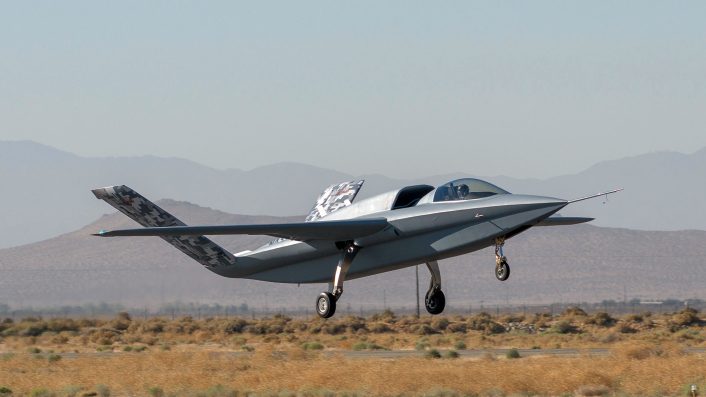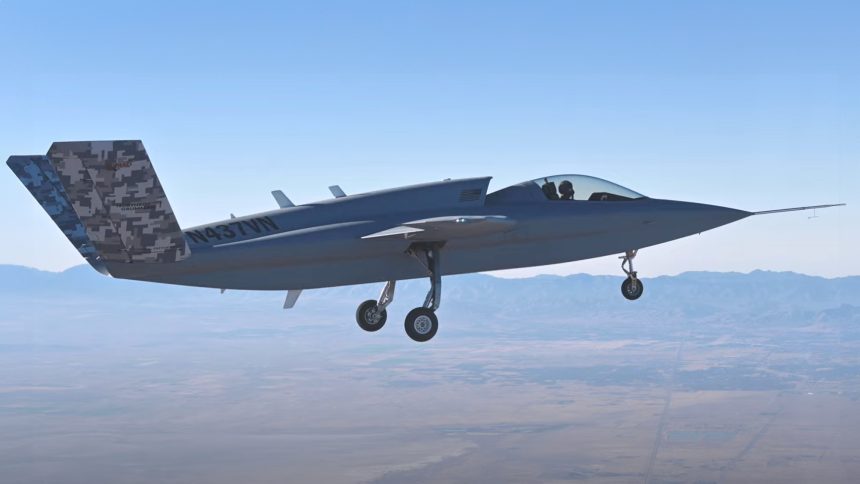A new video shows the Scaled Composites Model 437 Vanguard during its recent first flight.
On August 29, 2024, Scaled Composites’ new Model 437 aircraft, named Vanguard and registered as N437VN, completed its first flight at Mojave Air and Space Port in California. This aircraft marks another innovation by Scaled Composites, a company renowned for developing advanced and unconventional aerospace designs. The Vanguard is developed in collaboration with Northrop Grumman, which has brought its expertise in digital engineering and design to the project, leveraging extensive digital tools to streamline the development process and reduce costs.
Northrop Grumman has just released an interesting video about the first flight that includes the first air-to-air footage of the Model 437.
The Model 437 Vanguard was initially introduced in concept as an unmanned aircraft intended to operate as a “loyal wingman,” assisting manned aircraft in a range of missions. This concept was first showcased through official renderings in 2021, depicting the aircraft as a highly capable unmanned system with an estimated range of about 3,000 nautical miles, fueled by a payload capacity of 4,000 pounds and a cruise speed near Mach 0.8. However, recent developments have revealed that the aircraft includes a cockpit, transforming it into a crewed variant, which adds versatility to its operational potential.
Design-wise, the Vanguard features swept wings with trapezoidal sections near the root, complemented by a V-tail configuration. The airframe is equipped with a top-mounted air intake behind the cockpit, designed for optimal performance during flight. The aircraft is powered by a single Pratt & Whitney 535 engine, delivering approximately 3,400 pounds of thrust. With a wingspan and length of 41 feet each, and a gross takeoff weight of 10,000 pounds, the Model 437 is equipped for multi-mission roles, including potential payloads like AIM-120 AMRAAM missiles or a side-looking radar, which are aligned with its projected operational profile.
Scaled Composites emphasized its capability to rapidly design, fabricate, and test experimental aircraft. The Model 437’s development process involved a complete aircraft design from the ground up, including aerodynamic and structural analyses, fabrication of the fuselage and empennage, systems integration, and the execution of ground and flight tests. The aircraft’s structure and capabilities were inspired by the earlier Model 401 design, focusing on a low-cost, multi-mission platform suitable for attritable (expendable) roles in complex operational environments.

Northrop Grumman contributed to the project by defining, developing, and verifying the removable wing assemblies using advanced digital engineering tools, under its Digital Pathfinder initiative. This effort demonstrated the significant efficiencies gained from a fully digital engineering approach, with reported reductions in engineering rework to less than one percent, a marked improvement compared to traditional design processes where rework can range between 15 to 20 percent. Northrop Grumman has applied its expertise from other major programs, including insights gained from the development of the B-21 Raider stealth bomber.
The Vanguard’s first flight is a significant milestone for both Scaled Composites and Northrop Grumman, highlighting the ongoing evolution of aerospace capabilities through innovation and advanced digital processes. As testing continues, the aircraft is expected to fulfill multiple roles, demonstrating the scalability of its design and the benefits of integrating advanced technologies and methodologies in modern aircraft development. The collaborative effort showcases a path forward for future aircraft programs, blending rapid prototyping, digital design, and agile development to meet the complex demands of current and future aviation needs.
The Predecessor
As explained, the 437 is derived from another interesting aircraft: the Model 401.
The Model 401 Sierra project, developed by Scaled Composites, was designed as a low-cost technology demonstrator with a focus on streamlined manufacturing. It features a single pilot cockpit, is powered by a single turbofan engine, and operates at medium altitudes. The project led to the construction of two identical aircraft, which completed development from concept to first flight in just 24 months; the first flew in October 2017, followed by the second aircraft six months later.
These aircraft are informally known as “Sons of Ares,” a nod to Scaled Composites’ earlier Agile Responsive Effective Support (ARES) test jet. The aircraft have been further nicknamed Phobos and Deimos, reflecting their registration numbers N401XP and N401XD, and named after the Greek gods of fear and terror, who were also the sons of Ares, the god of war.
The Model 401, also referred to as Sierra by Scaled Composites, is among the most secretive non-military aircraft used for testing today. After initial flight tests to expand their performance envelope, both aircraft began payload development for a variety of customers, demonstrating their versatility. They boast an impressive payload capacity of over 80 cubic feet and can carry up to 2,000 pounds. Notable payloads have included what appears to be a laser-directed energy system, as observed in 2022, with a specialized pod mounted beneath the fuselage that featured markings suggestive of laser technology.
The aircraft’s capabilities suggest that it may also be involved in exploring defensive technologies against directed energy weapons. This aligns with previous sightings of a Model 401 sporting a mirror-like coating in 2020, preceding the adoption of similar coatings on various U.S. military aircraft like the F-22, F-35 variants, and even the F-117. These developments underline the Model 401’s role in pushing the boundaries of experimental aircraft technologies, leveraging its advanced design and integration capabilities to support a wide range of cutting-edge aerospace innovations.
Scaled Composites’ work on the Model 401 reflects their expertise in rapid design, prototyping, and testing of advanced experimental aircraft. The company has built the Sierra from scratch, conducting aerodynamic and structural analysis, as well as overseeing the complete process from fuselage fabrication to flight testing. The ongoing use of the Model 401s for diverse testing missions exemplifies Scaled Composites’ commitment to advancing aviation technology and maintaining the aircraft’s relevance in a dynamic aerospace landscape.









